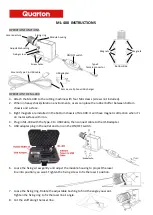
Practical monitoring of the measurement devices
Measurement device monitoring for the Fischerscope X-RAY
FISCHERSCOPE
®
X-RAY
117
samples can also be used to compare the measurement results of
two parties (e.g., supplier and customer) when calibration
standards are not available at one of the parties and one tries to
avoid shipping of relatively expensive calibration standards.
Reference samples
Reference samples are considered derivative or secondary
calibration standards. There are no alternatives to reference
samples if no primary standards are used or use of an annual
calibration service is made. When checking the standards, a
potentially existing difference between the substrate materials of
the sample and the substrate material of the calibration standard
must be taken into account: prior to the check measurement, the
measurement application must be set to the base material of the
calibration standard set, and after the check it must be reset to the
substrate material of the sample. Otherwise, the standard or the
sample would not be measured correctly. This is not necessary with
a reference sample because its substrate material is identical to
that of the measurement application. A prominent example would
be the check measurement of the measurement application Sn/
CuSn6 with Sn/Ni or Sn/Cu standards. Here, a measurement
without taking into account the fact that the calibration standard
does not contain Sn in the substrate material would result in a
reading with a value that is up to 2-3
μ
m too low.
The check measurement is carried out by making an equal number
of measurements (e.g., 5) under repeatability conditions within the
reference area of one and the same sample at regular intervals.
Each of these test series is called a
group
. The same measurement
time and the same base setting of the measurement application to
be checked are used as during the regular measurements. Each
group provides as its result one mean value and a measure for the
variation, e.g., the standard deviation. For each feature, these
measurement results are entered into a test protocol or even better
into a quality control chart (SPC chart). Documentation of the
measurement results is extremely important because only the
documentation provides the proof whether measurement readings
are correct using the current calibration and whether the instrument
is okay. Measurement device monitoring is unthinkable without
documentation and would not deserve its name.
Time intervals
The time intervals of the check measurements are determined by
the respective measurement application. We recommend verifying
simple measurement applications (e.g., Zn/Fe, Au/Ni, Sn/Cu etc.)
once a week. However, the user should verify more complex
measurement applications (e.g., Cr/Ni/Cu/Zn) every other day or
even once a day. The measurement application is to be re-verified
after every
correction
. The intervals may be increased if the
repeated verification never or only rarely shows a significant
deviation from the nominal value.
These recommended intervals indicate that annual checks with
standards by a calibration service of the manufacturer cannot
replace measurement device monitoring. If the manufacturer
Summary of Contents for FISCHERSCOPE X-RAY XDLM 231
Page 8: ...6 FISCHERSCOPE X RAY Table of Contents...
Page 14: ...12 FISCHERSCOPE X RAY Safety Information...
Page 30: ...28 FISCHERSCOPE X RAY Set up...
Page 36: ...34 FISCHERSCOPE X RAY WinFTM File Structure...
Page 52: ...50 FISCHERSCOPE X RAY User Interface of the WinFTM Software...
Page 134: ...132 FISCHERSCOPE X RAY Def MA...
Page 146: ...144 FISCHERSCOPE X RAY Programming Coordinates for Automatic Measurements XDLM 237...
Page 186: ...184 FISCHERSCOPE X RAY Pattern Recognition XDLM 237...
Page 192: ...190 FISCHERSCOPE X RAY Cleaning and Maintenance...
Page 202: ...200 FISCHERSCOPE X RAY Addendum...
Page 228: ...226 FISCHERSCOPE X RAY WinFTM SUPER For the Experienced X RAY User...
Page 229: ...FISCHERSCOPE X RAY 227...
Page 232: ......
















































